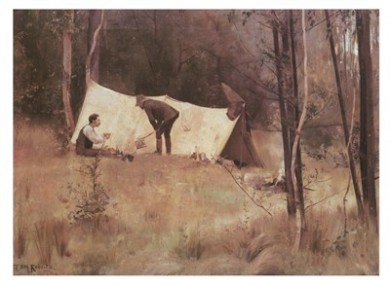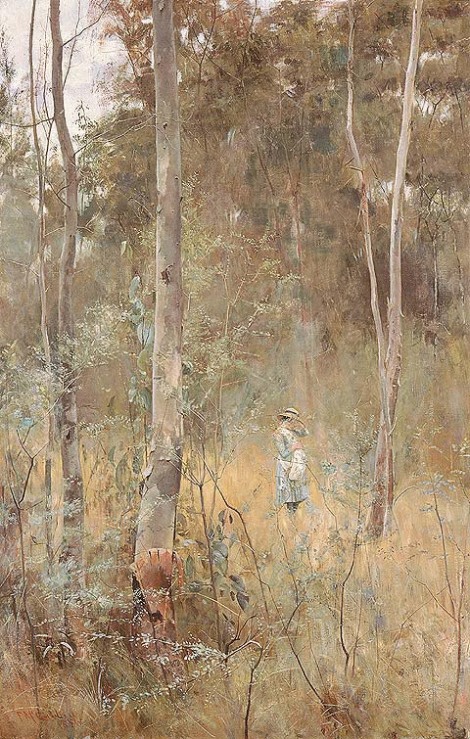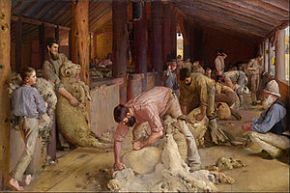There were some notable events which influenced art in Australia in the 19th century. Gold rushes resulted in many artists trying their luck in the goldfields. New individual wealth created markets for landscape paintings and portraiture. Civic prosperity led to colonial aspirations of grandeur. This in turn led to impressive buildings and public art collections.
Towards the 1880s artists were less interested in sending ‘postcard art’ back to europe, as John Glover, Conrad Martens, Louis Buvelot and others had done earlier. Instead there was a desire to capture the ‘real essence’ of the Australian landscape. New artistic styles continued to influence from europe. New techniques and ideas arrived with new settlers, as in the past. But for the first time Australian artists (although not necessarily Australian born) would travel to europe and return influenced by what they had seen.
Tom Roberts, was english-born, australian-raised, and having sold paintings in Melbourne, went to London from 1881-84 and studied at the Royal Academy. Influenced by the light and mood of James Whistler, the impressionists and the plein air movement Roberts returned to Australia intent on telling australian stories.
Left: The Boulevard Montmartre on a Winter Morning. Pisarro. 1897. Oil on canvas. The Metropolitan Museum of Art, New York, USA.
Right: Bourke Street west. Tom Roberts. c1885-86.
Tom Roberts was so taken with the plein air movement that he instigated camps with other artists. This got the men out into the countryside. Another painting in the NGV collection is The Artist’s Camp, 1886. In this painting Louis Abrahams (standing) and Frederick McCubbin have joined Roberts in camp. Here we see the quick brush work, the light and the moment captured; all strong features of impressionism.
Roberts organised further camps often with McCubbin. At one near Heidelberg (Victoria) they were joined by Arthur Streeton, Walter Withers and Charles Conder. They formed the core who were known in Victoria as the Heidelberg School. They were the Australian Impressionists.
The National Gallery of Victoria (NGV) has fantastic paintings by each of these artists. McCubbin’s Lost (1886) is a celebrated Australian painting which depicts a girl lost in the Australian country. At the time there had been several children who had disappeared in the bush and this was McCubbin’s tribute to them. With the tall eucalpyts and foliage it was easy to become disoriented in the bush. Here McCubbin shows a girl who has been collecting berries or nettles when she realises that she is lost. Of interest is the light and the earthy brown-green colours which McCubbin favoured.
Arthur Streeton in contrast was known for his golds and blues. He saw Australia as dry and hot as evident in “The purple noon’s transparent might of the Hawkesbury river”.
But finally I want to come back to Tom Roberts. Perhaps one of my favourite paintings in the NGV is his iconic Shearing the Rams (1890). If ever there was a painting of its time that said this is Australia, this is who we are or what we do, it was Shearing the Rams. Roberts brings to life the noise and heat of a woolshed, the smell of oily shorn wool. In my first years I grew up on a farm. I remember my grandfather, whom we called Garg, in his singlet and thick army surplus trousers, sweat dripping off him as he sheared sheep after sheep from morning til night. It was an exciting place the woolshed.
Shearing the Rams honours the rural economy. At the time wool was one of Australia’s great exports. Roberts was telling an Australian story for an Australian audience.
He tried to sell the painting to the National Gallery of Victoria. At the time they didn’t want it. But they did eventually.





